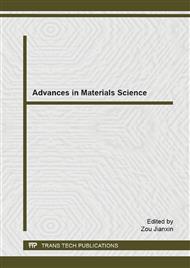[1]
M. Siegel, An Ecological Study of Arsenic-related Bladder Cancer in US counties: Effects of reference population and confounders on the calculated risks, New Mexico, Report SAND2004-1379P, Sandia National Laboratories, Albuquerque, NM. (2007).
Google Scholar
[2]
P. A. Shelmerdine, C. R. Black, S. P. McGrath, S. D. Young, Modelling phytoremediation by the hyperaccumulating fern, Pteris vittata, of soils historically contaminated with arsenic, Environ. Pollut ., 157 (2009) 1589-1596.
DOI: 10.1016/j.envpol.2008.12.029
Google Scholar
[3]
A.S. Kinsela, R.N. Collins, T. D. Waite. Speciation and transport of arsenic in an acid sulfate soil-dominated catchment, eastern Australia, Chemosphere, 82 (2011) 879-887.
DOI: 10.1016/j.chemosphere.2010.10.056
Google Scholar
[4]
J. Zhang, X. D. Liu, L. Jiang, Speciation analysis of arsenic in soil samples, Rock and mineral analysis, 3 (2008) 179-183.
Google Scholar
[5]
J. Chappell, B. Chiswell,H. Olszowy, Speciation of arsenic in a contaminated soil by solvent Extraction, Talanta, 42 (1995) 323-329.
DOI: 10.1016/0039-9140(95)01395-r
Google Scholar
[6]
I. M. M. Rahman, Z. A. Begum, M. Nakano, Y. Furusho, T. Maki, H. Hasegawa, Selective separation of arsenic species from aqueous solutions with immobilized macrocyclic material containing solid phase extraction columns, Chemosphere, 82 (2011).
DOI: 10.1016/j.chemosphere.2010.10.045
Google Scholar
[7]
H. M. Anawar , A. Garcia-Sanchez, I. Santa Regina, Evaluation of various chemical extraction methods to estimate plant-available arsenic in mine soils , Chemosphere, 70 (2008) 1459-1467.
DOI: 10.1016/j.chemosphere.2007.08.058
Google Scholar
[8]
W. Hammel, R. Debus, L. Steubing, Mobility of antimony in soil and its availability to plants, Chemosphere, 41 (2000) 1791-1798.
DOI: 10.1016/s0045-6535(00)00037-0
Google Scholar
[9]
V. Ettler, M. Mihaljevicˇ, O. Sˇebek, Z. Nechutny´, Antimony availability in highly polluted soils and sediments – A comparison of single extractions, Chemosphere, 68 (2007) 455-463.
DOI: 10.1016/j.chemosphere.2006.12.085
Google Scholar
[10]
S. Denys, K. Tack, J. Caboche, P. Delalain, Bioaccessibility, solid phase distribution and speciation of Sb in soils and in digestive fluids, Chemosphere, 74 (2008) 711-716.
DOI: 10.1016/j.chemosphere.2008.09.088
Google Scholar
[11]
W. Quiroz, D. Olivares, M. Bravo, J. Feldmann, A. Raab, Antimony speciation in soils: Improving the detection limits using post-column pre-reduction hydride generation atomic fluorescence spectroscopy (HPLC/pre-reduction/HG-AFS), Talanta, 84 (2011).
DOI: 10.1016/j.talanta.2011.01.018
Google Scholar
[12]
G. Okkenhaug, Y. G. Zhu, L. Luo, M. Lei , X. Li , J. Mulder . Distribution, speciation and availability of antimony (Sb) in soils and terrestrial plants from an active Sb mining area, Environmental Pollution, 159 (2011) 2427-2434.
DOI: 10.1016/j.envpol.2011.06.028
Google Scholar
[13]
K. Hockmann, M. Lenz, S. Tandy, M. Nachtegaal, M. Janousch, R. Schulin, Release of antimony from contaminated soil induced by redoxchanges, Journal of Hazardous Materials, 275 (2014) 215-221.
DOI: 10.1016/j.jhazmat.2014.04.065
Google Scholar
[14]
M. Tang, H. Z. Zhang, L. Li, Extraction remediation technologies of arsenic contaminated soils using citric acid, Environmental pollution and control, 12 (2010) 31-34.
Google Scholar
[15]
M. Jang, J. S. Hwang, S. I. Choi, Sequential soil washing techniques using hydrochloric acid and sodium hydroxide for remediatingarsenic-contaminated soils in abandoned iron-ore mines, Chemosphere, 66 (2007) 8-17.
DOI: 10.1016/j.chemosphere.2006.05.056
Google Scholar
[16]
S. Y. Oh, M. K. Yoon, I. -H. Kim, J.Y. Kim, W. Bae, Chemical extraction of arsenic from contaminated soil under subcritical conditions, Science of the Total Environment, 409 (2011) 3066-3072.
DOI: 10.1016/j.scitotenv.2011.04.054
Google Scholar
[17]
M. H. H. Abbas, A. A. Abdelhafez, Role of EDTA in arsenic mobilization and its uptake by maize grown on an As-polluted soil, Chemosphere, 90 (2013) 588-594.
DOI: 10.1016/j.chemosphere.2012.08.042
Google Scholar
[18]
S. Mukhopadhyay, S. Mukherjee, M. A. Hashim, B. S. Gupta, Application of colloidal gas aphron suspensions produced from Sapindus mukorossi for arsenic removal from contaminated soil, Chemosphere, 119 (2015) 355-362.
DOI: 10.1016/j.chemosphere.2014.06.087
Google Scholar
[19]
M. Rivero-Huguet, W. D. Marshall, Scaling up a treatment to simultaneously remove persistent organic pollutants and heavy metals from contaminated soils, Chemosphere, 83 (2011) 668-673.
DOI: 10.1016/j.chemosphere.2011.02.007
Google Scholar
[20]
Z. Min, L. Bohan, L. Ming, Z. Yong, Z. Qingru, O. Bin, Arsenic removal from contaminated soil using phosphoric acid and phosphate, Journal of Environmental Sciences, 20 (2008) 75-79.
DOI: 10.1016/s1001-0742(08)60011-x
Google Scholar
[21]
V. Achal, X. Pan, Q. Fua, D. Zhang, Biomineralization based remediation of As(III) contaminated soil by Sporosarcina ginsengisoli, Journal of Hazardous Materials, 201-202 (2012) 178-184.
DOI: 10.1016/j.jhazmat.2011.11.067
Google Scholar
[22]
P. Jankong, P. Visoottiviseth, Effects of arbuscular mycorrhizal inoculation on plants growing on arsenic contaminated soil, Chemosphere, 72 (2008) 1092–1097.
DOI: 10.1016/j.chemosphere.2008.03.040
Google Scholar
[23]
K. Vaxevanidou, N. Papassiopi, I. Paspaliaris, Removal of heavy metals and arsenic from contaminated soils using bioremediation and chelant extraction techniques, Chemosphere, 70 (2008) 1329-1337.
DOI: 10.1016/j.chemosphere.2007.10.025
Google Scholar
[24]
W. She, Y. C. Jie, H. C. Xing, M. Huang, W. L. Kang, Y. W. Lu, D. Wang, Uptake and accumulation of heavy metal by ramie (boehmeria nivea) growing on antimony mining area in Lengshuijiang city of Hunan province, Journal of Agro-environment science, 1 (2010).
Google Scholar
[25]
R. Cidu, R. Biddau, E. Dore, A. Vacca, L. Marini, Antimony in the soil–water–plant system at the Su Suergiu abandoned mine (Sardinia, Italy): Strategies to mitigate contamination, Science of the Total Environment, 497 (2014) 319-331.
DOI: 10.1016/j.scitotenv.2014.07.117
Google Scholar
[26]
M. E. Henry Bergmann , A. Savas Koparal, Electrochemical antimony removal from accumulator acid: Results from removal trials in laboratory cells, Journal of Hazardous Materials, 196 (2011) 59- 65.
DOI: 10.1016/j.jhazmat.2011.08.073
Google Scholar
[27]
P. Dorjee, D. Amarasiriwardena, B. Xing, Antimony adsorption by zero-valent iron nanoparticles (nZVI): Ion chromatography–inductively coupled plasma mass spectrometry (IC–ICP-MS) study, Microchemical Journal, 116 (2014) 15-23.
DOI: 10.1016/j.microc.2014.03.010
Google Scholar


